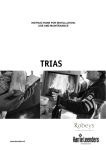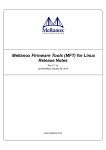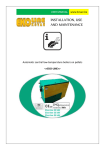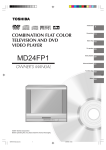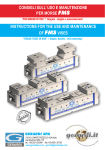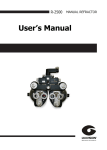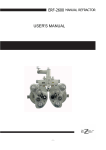Download Toshiba SD-P7000 17 in. TV/DVD Combo
Transcript
COMBINATION LCD TELEVISION AND DVD VIDEO PLAYER SD-P7000 OWNER’S MANUAL ©2004 Toshiba Corporation Before operating the unit, please read this manual thoroughly. Introduction 3 Connections 15 TV Operation 20 DVD&VCD Operation 35 MP3/WMA files Operation 43 Audio CD Operation 44 JPEG file Operation 46 Others 47 Introduction Regulatory compliance statements United States of America Federal Communications Commission (FCC) Unintentional emitter per FCC Part 15 This device has been tested and found to comply with the limits for a Class B digital device, pursuant to Part 15 of the FCC rules. These limits are designed to provide reasonable protection against harmful interference in a residential installation. This equipment generates, uses, and can radiate radio frequency energy and, if not installed and used in accordance with the instructions, may cause harmful interference to radio or television reception. However, there is no guarantee that interference will not occur in a particular installation. If this equipment does cause interference to radio and television reception, which can be determined by turning the equipment off and on, the user is encouraged to try to correct the interference by one or more of the following measures: v v v v Reorient or relocate the receiving antenna Increase the separation between the equipment and receiver Connect the equipment to an outlet on a different circuit from that to which the receiver is connected Consult the dealer or an experienced radio/TV technician for help. FCC declaration of conformity This device complies with Part 15 of the FCC Rules. Operation of this device is subject to the following two conditions: (1) this device may not cause harmful interference, and (2) this device must accept any interference received, including interference that may cause undesired operation. Changes or modifications not expressly approved by Toshiba could void the FCC compliance and negate your authority to operate the product. Canada Industry Canada (IC) Unintentional emitter per ICES-003 This digital apparatus does not exceed the Class B limits for radio noise emissions from digital apparatus as set out in the radio interference regulations of Industry Canada. Le présent appareil numérique n’émet pas de bruits radioélectriques dépassant les limites applicables aux appareils numériques de Classe B prescrites dans le règlement sur le brouillage radioélectrique édicté par Industrie Canada. California Law Proposition 65 Warning WARNING Handling the cord on this product or cords associated with accessories sold with this product, will expose you to lead, a chemical known to the State of California to cause birth defects or other reproductive harm. Wash hands after handling. Vermont and Connecticut Mercury Warning WARNING This LCD TV/DVD Combination contains mercury. Disposal of mercury may be regulated due to environmental considerations. For disposal or recycling information, please contact your local authorities or the Electronic Industries Alliance: www.eiae.org. 2 IMPORTANT SAFEGUARDS Introduction CAUTION RISK OF ELECTRIC SHOCK DO NOT OPEN WARNING: TO REDUCE THE RISK OF ELECTRIC SHOCK DO NOT REMOVE COVER (OR BACK). NO USER SERVICEABLE PARTS INSIDE. REFER TO QUALIFIED SERVICE PERSONNEL. The lightning flash with arrowhead symbol, within an equilateral triangle, is intended to alert the user to the presence of uninsulated “dangerous voltage” within the product’s enclosure that may be of sufficient magnitude to constitute a risk of electric shock to persons. The exclamation point within an equilateral triangle is intended to alert the user to the presence of important operating and maintenance (servicing) instructions in the literature accompanying the appliance. NOTE TO CABLE/TV INSTALLER: This reminder is provided to call the CATV system installer’s attention to Article 820-40 of the National Electric Code (U.S.A.). The code provides guidelines for proper grounding and, in particular, specifies that the cable ground shall be connected to the grounding system of the building, as close to the point of the cable entry as practical. For additional antenna grounding information, see items 25 and 26 on page 5. CAUTION: Do not attempt to modify this product in any way without written authorization from Toshiba Corporation. Unauthorized modification could void the user’s authority to operate this product. This LCD TV employs a Laser System. To ensure proper use of this product, please read this owner’s manual carefully and retain for future reference should the unit require maintenance, contact an authorized service location. Use of controls, adjustments, or the performance of procedures other than those specified herein may result in hazardous radiation exposure. To prevent direct exposure to laser beam, do not try to open the enclosure. Visible laser radiation when open. DO NOT STARE INTO BEAM. 3 Introduction IMPORTANT SAFEGUARDS (Continued) WARNING : To Reduce The Risk Of Fire Or Electric Shock, Do Not Expose This Apparatus To Rain Or Moisture. Apparatus shall not be exposed to dripping or splashing and no objects filled with liquids, such as vases, shall be placed on the apparatus. CAUTION : To reduce the risk of electric shock, do not perform any servicing other than that contained in the operating instructions unless you are qualified to do so. Important Safety Instructions 1. Read these instructions. 2. Keep these instructions. 3. Heed all warnings. 4. Follow all instructions. 5. Do not use this apparatus near water. 6. Clean only with dry cloth. 7. Do not block any of the ventilation openings. Install in accordance with the manufacturer’s instructions. 8. Do not install near any heat sources such as radiators, heat registers, stoves, or other apparatus (including amplifiers) that produce heat. 9. Do not defeat the safety purpose of the polarized or grounding type plug. A polarized plug has two blades with one wider than the other. A grounding type plug has two blades and a third grounding prong. The wide blade or the third prong is provided for your safety. When the provided plug does not fit into your outlet, consult an electrician for replacement of the obsolete outlet. 10. Protect the power cord from being walked on or pinched particularly at plugs, convenience receptacles, and the point where they exit from the apparatus. 11. Only use the attachments / accessories specified by the manufacturer. 12. Use only with a cart, stand, tripod, bracket, or table specified by the manufacturer, or sold with the apparatus. When a cart is used, use caution when moving the cart / apparatus combination to avoid injury from tip-over. 13. Unplug this apparatus during lightning storms or when unused for long periods of time. 14. Refer all servicing to qualified service personnel. Servicing is required when the apparatus has been damaged in any way, such as power supply cord or plug is damaged, liquid has been spilled or objects have fallen into the apparatus, the apparatus has been exposed to rain or moisture, does not operate normally, or has been dropped. 15. CAUTION: To reduce the risk of electric shock, do not use the polarized plug with an extension cord, receptacle, or other outlet unless the blades can be inserted completely to prevent blade exposure. 4 Installation, Care, and Service Introduction Installation Follow these recommendations and precautions and heed all warnings when installing your TV: 16. Never modify this equipment. Changes or modifications may void: a) the warranty, and b) the user’s authority to operate this equipment under the rules of the Federal Communications Commission. 17. DANGER: RISK OF SERIOUS PERSONAL INJURY, DEATH, OR EQUIPMENT DAMAGE! Never place the TV on an unstable cart, stand, or table. The TV may fall, causing serious personal injury, death, or serious damage to the TV. 18. Never place or store the TV in direct sunlight; hot, humid areas; areas subject to excessive dust or vibration; or locations with temperatures at or below 41 °F (5 °C). 19. Always place the TV on the floor or a sturdy, level, stable surface that can support the weight of the unit. 20. Never place items such as vases, aquariums, or candles on top of the TV. 21. Never block or cover the slots or openings in the TV cabinet back, bottom, and sides. Never place the TV: v on a bed, sofa, rug, or similar surface; v too close to drapes, curtains, or walls; or v in a confined space such as a bookcase, built-in cabinet, or any other place with poor ventilation. The slots and openings are provided to protect the TV from overheating and to help maintain reliable operation of the TV. 22. Never allow anything to rest on or roll over the power cord, and never place the TV where the power cord is subject to wear or abuse. 23. Never overload wall outlets and extension cords. 24. Always operate this equipment from a 120 VAC, 60 Hz power source only. 25. Always make sure the antenna system is properly grounded to provide adequate protection against voltage surges and built-up static charges (see Section 810 of the National Electric Code). Antenna lead-in wire Antenna discharge unit (NEC section 810-20) Electric service equipment Grounding conductors (NEC section 810-21) Ground clamps Power service grounding electrode system (NEC Art 250 part H) 26. DANGER: RISK OF SERIOUS PERSONAL INJURY OR DEATH! Use extreme care to make sure you are never in a position where your body (or any item you are in contact with, such as a ladder or screwdriver) can accidentally touch overhead power lines. Never locate the antenna near overhead power lines or other electrical circuits. Never attempt to install any of the following during lightning activity: a) an antenna system; or b) cables, wires, or any home theater component connected to an antenna or phone system. v v 5 Introduction IMPORTANT SAFEGUARDS (Continued) Care For better performance and safer operation of your TOSHIBA TV, follow these recommendations and precautions: 27. Always sit approximately 10 –25 feet away from the TV and as directly in front of it as possible. The picture can appear dull if you sit too far to the left or right of the TV, or if sunlight or room lights reflect on the screen. Turn the TV off to check for reflections on the screen, and then remove the source of reflections while viewing the TV. 28. Always unplug the TV before cleaning. Never use liquid or aerosol cleaners. 29. WARNING: RISK OF ELECTRIC SHOCK! Never spill liquids or push objects of any kind into the TV cabinet slots. 30. For added protection of your TV from lightning and power surges, always unplug the power cord and disconnect the antenna from the TV if you leave the TV unattended or unused for long periods of time. 31. During normal use, the TV may make occasional snapping or popping sounds. This is normal, especially when the unit is being turned on or off. If these sounds become frequent or continuous, unplug the power cord and contact a Toshiba Authorized Service Center. Service 32. WARNING: RISK OF ELECTRIC SHOCK! Never attempt to service the TV yourself. Opening and removing the covers may expose you to dangerous voltage or other hazards. Refer all servicing to a Toshiba Authorized Service Center. 33. If you have the TV serviced: v v Ask the service technician to use only replacement parts specified by the manufacturer. Upon completion of service, ask the service technician to perform routine safety checks to determine that the TV is in safe operating condition. 34. When the TV reaches the end of its useful life, ask a qualified service technician to properly dispose of the TV. The fluorescent lamp in the LCD panel contains a small amount of mercury. 6 Precautions u When shipping the unit, the original shipping carton and packing materials come in handy. For maximum protection, repack the unit as it was originally packed at the factory. u Do not use volatile liquids, such as insect spray, near the unit. Do not leave rubber or plastic products in contact the unit for prolonged period. They will leave marks on the finish. u The top and rear panels of the unit may become warm after a long period of use. This is not a malfunction. u When the unit is not in use, be sure to remove any discs and turn off the power. u The unit may not function properly if you do not use it for a long period of time. It is recommended that you turn the unit on occasionally to prevent potential problems in operation. Notes on locating u Place the unit on a level surface. Do not use it on a shaky or unstable surface such as a wobbling table or inclined stand. The loaded disc may become disaligned and damage the unit. u When you place this unit near a TV, radio, or VCR, the playback picture may become poor and the sound may be distorted. In this case, place the unit away from the TV, radio, or VCR. Notes on moisture condensation Introduction Notes on handling Moisture condensation damages the unit. Please read the following carefully. Moisture condensation occurs, for example, when you pour a cold drink into a glass on a warm day. Drops of water form on the outside of the glass. In the same way, moisture may condense on the optical pick-up lens inside this unit, one of the most crucial internal parts of the unit. le of mo Examp ensat isture ion! cond Optical pick-up lens u Moisture condensation may occur in the following cases. v When you bring the unit directly from a cold place to a warm place. v When you use the unit in a room where you just turned on the heater, or a place where the cold wind from the air conditioner directly hits the unit. v In summer, when you use the unit in a hot and humid place just after you move the unit from an air conditioned room. v When you use the unit in a humid place. Notes on cleaning Use a soft, dry cloth for cleaning. v Do not use any type of solvent, such as thinner and benzine, as they may damage the surface of the unit. v If you use a chemical saturated cloth to clean the unit, follow that product’s instructions. u Do not use the unit when moisture condensation may occur. If you use the unit in such a situation, it may damage discs and internal parts. Remove the disc, connect the power cord of the unit to the wall outlet, turn on the unit, and leave it for two or three hours. After two or three hours, the unit will have warmed up and evaporated any moisture. Keep the unit connected to the wall outlet and moisture condensation will seldom occur. Wa it! Wall outlet 7 Introduction Notes on discs On handling discs Structure of disc contents v Do not touch the playback side of the disc. Normally, DVD video discs are divided into titles, and the titles are sub-divided into chapters. Video CDs and Audio CDs are divided into tracks. DVD video disc DVD video disc Title 1 Title 2 Chapter 1 Chapter 2 Chapter 3 Chapter 4 Chapter 5 Playback side v Do not attach paper or tape to discs. Video CD/Audio CD Video CD/Audio CD Track 1 Track 2 Track 3 Track 4 Track 5 On cleaning discs v Fingerprints and dust on the disc cause picture and sound deterioration. Wipe the disc from the center outwards with a soft cloth. Always keep the disc clean. v Do not use any type of solvent such as thinner, benzine, commercially available cleaners or antistatic spray for vinyl LPs. It may damage the disc. On storing discs v Do not store discs in a place subject to direct sunlight or near heat sources. v Do not store discs in places subject to moisture and dust such as a bathroom or near a humidifier. v Store discs vertically in a case. Stacking or placing objects on discs outside of their case may cause warping. 8 Each title, chapter or track is assigned a number, which is called “title number”, “chapter number” or “track number” respectively. There may be discs that do not have these numbers. Notes • If an MP3 or JPEG file CD is created using an incorrect method, the player may not be able to recognize it. If this happens, try reburning another CD after setting up the disc writing parameters correctly on your PC. • Manufactured under license from Dolby Laboratories. Dolby and the double-D symbol are trademarks of Dolby Laboratories. • DTS and DTS Digital Out are trademarks of Digital Theater Systems, Inc. Notes on copyright It is forbidden by law to copy, broadcast, show, broadcast on cable, play in public, and rent copyrighted material without permission. DVD video discs are copy protected, and any recordings made from these discs will be distorted. This product incorporates copyright protection technology that is protected by method claims of certain U.S. patents and other intellectual property rights owned by Macrovision Corporation and other rights owners. Use of this copyright protection technology must be authorized by Macrovision Corporation, and is intended for home and other limited viewing uses only unless otherwise authorized by Macrovision Corporation. Reverse engineering or disassembly is prohibited. This DVD player is designed and manufactured for playback of region “1” encoded DVD software. The region code on the labels of some DVD discs indicates which type of player can play those discs. This unit can play only DVD discs labeled “1” or “ALL”. If you try to play any other discs, the message “Check Regional Code” will appear on the TV screen. Some DVD discs may not have a region code label even though their playback is prohibited by area limits. Playable discs Introduction Notes on region numbers This unit can play the following discs. Disc Mark Contents Disc Size Maximum playback time Approx. 4 hours (single sided disc) 12 cm Approx. 8 hours (double sided disc) Audio + Video (moving pictures) DVD video discs Approx. 80 minutes (single sided disc) 8 cm On Video CDs This DVD supports Video CDs equipped with the PBC (Version 2.0) function. (PBC is the abbreviation of Playback Control.) You can enjoy two playback variations depending on types of discs. • Video CD not equipped with PBC function (Version 1.1) Sound and movie can be played on this DVD in the same way as an audio CD. • Video CD equipped with PBC function (Version 2.0) In addition to operation of a Video CD not equipped with the PBC function, you can enjoy playback of interactive software with search function by using the menu displayed on the TV screen (Menu Playback). Some of the functions described in this owner’s manual may not work with some discs. About this owner’s manual This owner’s manual explains the basic instructions of this unit. Some DVD video discs are produced in a manner that allows specific or limited operation during playback. As such, the unit may not respond to all operating commands. This is not a defect in the unit. Refer to instruction notes of discs. “ ” may appear on the TV screen during operation. A“ ” means that the operation is not permitted by the unit or the disc. For example, sometimes it is unable to stop the playback of copyright message of the disc when the STOP button is pressed. Alternatively, the “ ” may also indicate that the feature is not available for the disc. Approx. 160 minutes (double sided disc) Video CDs DIGITAL VIDEO Audio CDs Audio + Video (moving pictures) 12 cm Approx. 74 minutes 8 cm Approx. 20 minutes 12 cm Approx. 74 minutes Audio 8 cm (CD Approx. 20 minutes single) The following discs are also available. •CD-R/CD-RW discs of CD-DA, Video CD, MP3, WMA or JPEG format •Kodak Picture CD and FUJICOLOR CD format. Some of these discs may be incompatible. • You cannot play discs other than those listed above. • You cannot play discs of DVD-RAM, DVD-ROM, Photo CD, etc., or non standardized discs even if they may be labeled as above. • Some CD-R/RWs can not be played back depending on the recording conditions. • This unit uses the NTSC color system, and cannot play DVD video discs recorded in any other color system (PAL, SECAM, etc). Because of problems and errors that can occur during the creation of DVD software and/or the manufacture of DVD discs, Toshiba America Consumer Products, Inc., and Toshiba of Canada, Ltd. cannot guarantee that this unit will play every feature of every DVD bearing the DVD logo. As one of the creators of DVD technology, this unit is manufactured to the highest standards of quality and, as a result, such incompatibilities are very rare. If you happen to experience and difficulty playing a DVD on this unit, please feel free to call our Contact listed in "How to Obtain Warranty Services" (page 51). 9 Contents Introduction DVD&VCD operation IMPORTANT SAFEGUARDS.......................... 3 Precautions ..................................................... 5 Notes on discs................................................. 8 Contents .......................................................... 10 Identification of controls .................................. 11 DVD&VCD operation ..................................... 35 Connections External equipment connections ................... 15 Antenna Connection & Cable without a Cable box .......... 15 VCR Setup ..................................................................... 16 Cable TV Setup .............................................................. 16 External A/V Source Setup............................................. 17 External DVD Setup........................................................ 17 DTV Setup....................................................................... 18 Using Headphones......................................................... 18 DVD Output Setup.......................................................... 18 PC Setup......................................................................... 19 TV operation TV operation .................................................. Channel Menu Options.................................. Picture Menu Options ................................... Sound Menu Options .................................... Time Menu Options ....................................... Special Menu Options ................................... PC Menu Options .......................................... Antenna Connection & Cable without a Cable box 10 20 22 24 25 27 29 34 DVD Menu Options ........................................ 39 MP3/WMA files Playback Options ..............43 Audio CD Playback Options ........................44 JPEG file viewing Options ........................46 Others Troubleshooting .............................................. 47 Specifications .................................................. 49 Limited warranty .............................................. 50 Introduction Identification of controls Introduction Front POWER Button CHANNEL Buttons VOLUME Buttons PLAY Button STOP Button SKIP Buttons INPUT SELECT Button EJECT Button Disc Slot: Place a disc in the disc slot. Note : Insert a disc with the logo-printed side facing the front. Power/Standby Indicator Glows orange in Standby mode, Glows green when the TV is turned on. Remote Control Sensor Side Adjusting the angle of the base Left Side Right Side Approx. 10° 0° Approx. 3° You can adjust the angle of the TV-screen by 3° forward or by 10° backward from vertical angle. 11 Introduction Identification of controls (Continued) Rear Headphone Jack S-Video Input Video Input Audio Input ANT IN 75 DVD Video Output AC Input DVD Audio Output DVD/DTV Input Component (480i/480p/720p/1080i) 12 Antenna Input PC Input Digital Sound Optical Output PC Sound Input Introduction Remote control The instructions in this manual describe the function on the remote control. See the page in for details. RMT CODE(1/2) [1]: For controlling SD-P7000 model and other Toshiba brand TV. [2]: For controlling SD-P7000 model only. POWER button POWER INPUT SELECT RMT CODE 1 2 Switches the TV between ON and STANDBY. SET UP SET UP button SLEEP button 28 MEMORY button 37/45 REPEAT button 36/43 DISPLAY button 36/44 CAP/TEXT button 30 RANDOM button 38 INPUT SELECT button Selects: TV, Video, S-Video, DVD, Component, or PC mode. MEMORY DISPLAY SLEEP DIMMER REPEAT REPEAT A-B CLEAR MONO/ CAP/TEXT STEREO/SAP PICTURE RANDOM Direct channel selection buttons (0-9) Numbered buttons (0-9) E.A.M. AUDIO 1 2 3 4 5 6 7 8 9 0 T E.A.M. button 37/43 DIMMER button 24 CLEAR button 37/45 REPEAT A-B button 36 PICTURE button 24 MONO/STEREO/SAP button 26 AUDIO button 38 +10 100 +10 button 37/45 100 TOP MENU T button 38 MENU TOP MENU button 36 MENU button 36 Direction buttons ( / / / ) ENTER SKIP SKIP buttons 35 VOLUME +/- button SKIP VOLUME CHANNEL MUTE + - CHANNEL PLAY button MUTE button PLAY button 35 REV PAUSE FWD SLOW REV buttons 35 SLOW REV STOP SLOW FWD STOP button 35 ZOOM REV button 35 / ANGLE SUB TITLE RETURN Use to turn the sound on or off temporarily. FWD button 35 SLOW FWD button 35 PAUSE button 35 ZOOM button 37 RETURN button ANGLE button 37 Allows you to go back to the last scene you were watching. SUB TITLE button 39 13 Introduction Inserting batteries 1 Slide the battery compartment cover in the direction of the arrow. 2 Install two “AA” batteries (supplied), paying attention to the polarity diagram in the battery compartment. 3 Replace the compartment cover. Operation • Aim the remote control at the remote sensor and press control buttons to operate. • Operate the remote control within 30° angle on either side of the remote sensor, up to a distance of approx. 7 meters (Approx. 21 feet). Approx. 7 meters (Approx. 21 feet) The precautions below should be followed when using batteries in this device: 1. Use only the size and type of batteries specified (AA type). 2. Be sure to follow the correct polarity when installing the batteries as indicated in the battery compartment. Reversed batteries may cause damage to the device. 3. Do not mix different types of batteries together (e.g. Alkaline and Carbon-zinc) or old batteries with fresh ones. 4. If the device is not to be used for a long period of time, remove the batteries to prevent damage or injury from possible battery leakage. 5. Do not try to recharge batteries not intended to be recharged; they can overheat and rupture (follow battery manufacturer’s directions). 6. Dispose of used batteries in a designated disposal area. Do not throw batteries into a fire. Attention should be drawn to the environmental aspects of battery disposal. 14 ANT IN 75 Connections External equipment connections To prevent the equipment damage,never plug in any power cords until you have finished connecting all equipment. Antenna Connection & Cable without a Cable box - For optimum picture quality, adjust antenna direction. - An antenna cable and converter are not supplied. Connections Connecting to an Inside Antenna Setup - Typical wall antenna jack used in apartment buildings, connect the antenna cable as shown below. (Use the correct type of antenna cable for the type of wall antenna jack.) ANT IN 75 ANT IN 75 Turn clockwise to tighten. 75Ω Round Cable Bronze Wire 300Ω Flat Wire Apartment Buildings Antenna Converter (Not supplied) Wall Connection Jack Antenna Jack - If you have a 75Ω round cable, insert the bronze wire and then tighten the connection nut. If you have a 300Ω flat wire, connect ANT IN the twisted wire to the antenna converter and then connect the converter to the antenna jack on the TV. 75 - If using 75Ω round cable, do not bend the bronze wire. It may cause poor picture quality. Connecting to an Outside Antenna Setup - This type of antenna is commonly used in single family dwellings. ANT IN 75 VHF Antenna Turn clockwise to tighten. UHF Antenna 75Ω Round Cable Bronze Wire 300Ω Flat Wire Antenna Converter (Not supplied) Single Family Home - In poor signal areas, to get better picture quality, install a signal amplifier to the antenna as shown to the right. - If signal needs to be split for two TVs, use an antenna signal splitter for connection. Antenna Jack ANT IN 75 VHF UHF Signal Amplifier 15 Connections External equipment connections (Continued) The connection cables are not supplied. VCR Setup Connection 1 ANT IN 75 Set VCR CH switch to 3 or 4 and then tune TV to the same channel number. Connection 2 1. Connect the audio/video output jacks on the VCR to the corresponding input jacks on the TV. When connecting the TV to a VCR, match the jack colors (Video = yellow, Audio Left = white, and Audio Right = red). 2. Insert a video tape into the VCR and press PLAY on the VCR. (Refer to the VCR owner’s manual.) 3. Use the INPUT SELECT button on the remote control to select Video. (If connected to S-VIDEO on the side panel, select the S-Video external input source.) TV Back Panel 1 Typical Antennas 2 TV Side Panel ANT OUT S-VIDEO OUT ANT IN CH3 IN CH4 (R) AUDIO (L) VIDEO VCR Cable TV Setup - After subscribing to a local cable TV service and installing a converter, you can watch cable TV programming. - For further cable TV information, contact your local cable service provider. Connection 1 1. Select channel 3 or 4 with the channel switch on the cable box. 2. Tune the TV channel to the same selected output channel of the cable box. 3. Select channels at the cable box or with the cable box remote control. Connection 2 1. Connect the audio/video output jacks on the Cable Box to the corresponding input jacks on the TV. When connecting the TV to the Cable Box, match the jack colors (Video = yellow, Audio Left = white, and Audio Right = red). 2. Use the INPUT SELECT button on the remote control to select Video. 3. Select channels using the cable box remote control. 16 ANT IN 75 TV Back Panel 2 1 TV RF Cable VCR VIDEO Cable Box (R) AUDIO (L) TV Side Panel External A/V Source Setup Connect the audio/video output jacks on the external A/V equipment to the corresponding input jacks on the TV. When connecting the TV to external A/V equipment, match the jack colors (Video = yellow, Audio Left = white, and Audio Right = red). Connections Connections TV Side Panel Viewing Setup 1. Turn on the external A/V equipment. 2. Use the INPUT SELECT button on the remote control to select Video. 3. Operate the corresponding external equipment. Refer to the external equipment operating guide. Camcorder VIDEO R AUDIO L External Equipment Video Game set External DVD Setup - This TV can play a DVD without a separate DVD player. However, if you want to watch a DVD from a separate DVD player, refer to the figure as shown on the right. Connections Connect the DVD video outputs to the COMPONENT (Y, PB, PR) jacks and connect the DVD audio outputs to the AUDIO jacks. TV Back Panel Viewing Setup 1. Turn on the DVD player, insert a DVD disc. 2. Use the INPUT SELECT button on the remote control to select Component. 3. Refer to the DVD player's manual for operating instructions. • Component Input ports To get better picture quality, connect a DVD player to the component input ports as shown below. Component ports of the TV Y PB Video output ports of DVD player Y Y Y Y Pr Pb B-Y R-Y Cb Cr PB PR PR TV Side Panel Y PB DVD PR (R) AUDIO (L) External DVD 17 Connections Connecting to optional equipment (Continued) DTV Setup - To watch digitally broadcast programs, purchase and connect a digital set-top box. Connections Connect the digital set-top box video outputs to the COMPONENT (Y, PB, PR) jacks and connect the digital set-top box audio outputs to the AUDIO jacks. TV Back Panel Viewing Setup 1. Turn on the digital set-top box. (Refer to the owner’s manual for the digital set-top box.) 2. Use the INPUT SELECT button on the remote control to select Component. TV Side Panel Y PB PR (R) AUDIO (L) DTV Receiver (Set-top Box) Using Headphones - Plug headphones into the H/P jack as shown. - Adjust the sound level of the headphone using the VOLUME ( + , -) buttons. While you are listening through a headphone(s), TV speakers will not be heard. ANT IN 75 TV Side Panel DVD Output Setup The TV has a special signal output capability which allows you to hook up a second TV or monitor. Connect the second TV or monitor to the TV’s DVD OUTPUT and OPTICAL DIGITAL SOUND OUT jack. (See the Operating Manual of the second TV or monitor for further details regarding that device’s input settings.) Notes: • If your second TV or monitor has no optical digital audio input jack, it’s impossible to use DVD digital sound output. • Do not look into the optical output port. Looking at the laser






















































